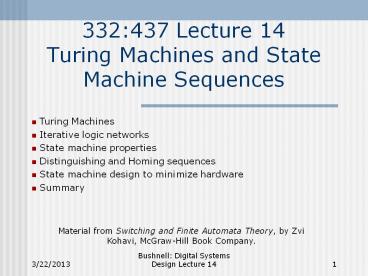332:437 Lecture 14 Turing Machines and State Machine Sequences - PowerPoint PPT Presentation
1 / 18
Title:
332:437 Lecture 14 Turing Machines and State Machine Sequences
Description:
332:437 Lecture 14 Turing Machines and State Machine Sequences Turing Machines Iterative logic networks State machine properties Distinguishing and Homing sequences – PowerPoint PPT presentation
Number of Views:254
Avg rating:3.0/5.0
Title: 332:437 Lecture 14 Turing Machines and State Machine Sequences
1
332437 Lecture 14Turing Machines and State
Machine Sequences
- Turing Machines
- Iterative logic networks
- State machine properties
- Distinguishing and Homing sequences
- State machine design to minimize hardware
- Summary
Material from Switching and Finite Automata
Theory, by Zvi Kohavi, McGraw-Hill Book Company.
2
Turing and State Machines
- State Machines
- Called non-writing machines
- Have no control on their external input
- Cannot write or change their inputs
- Turing Machine after A. M. Turing
- A writing machine
- Finite State Machine capable of modifying its own
input symbols - Fundamental Theoretical Model of all digital
computers
3
Turing Machine
- Tape divided into squares each contains a
symbol (blank squares store a 0) - Head has 3 operations
- Read symbol in square being scanned
- Write new symbol in scanned square
- Shift tape 1 square in either direction
4
Turing Machine (contd.)
5
Cycle of Computation
- Start in state Si
- Read symbol under head
- Write new symbol
- Shift left/right
- Enter new state Sj
6
Turing Machine Example
7
Turing Machine Properties
- Anything a Universal Turing Machine can do, a
digital computer can do - Anything a Universal Turing Machine cannot do, a
digital computer cannot do - Emulation A Universal Turing Machine can mimic
or emulate the behavior of any other Turing
Machine (and therefore, so can a computer) - Halting Problem A Universal Turing Machine (and
therefore a computer) cannot predict when the
computation of another Turing Machine will
complete, and when it will not
8
Iterative Logic Network
- Digital structure having cascade of identical
cells - Each may be a sequential circuit
- Every finite output sequence that can be produced
sequentially by a sequential machine can be
produced spatially (or simultaneously) by a
combinational iterative
network - Cell Table like State
Machine transition table
9
Example Iterative Logic Array
l inputs m outputs
k state variables i time frames
10
Iterative Logic Arrays
- If same assignment used for iterative network as
for sequential circuit - Logic of cell combinational logic of sequential
circuit are identical - cells in iterative network must equal length of
input patterns - Iterative network is a time-unraveled history of
the inputs to the state machine
11
Formal Definition of Finite State Machine
- State Transition Function
- S (t 1) d S (t), x (t)
- Output Function
- z (t) l S (t), x (t)
- Synchronous Sequential Machine quintuple
- M (I, O, S, d, l)
- d I X S S
- l I X S O
- S O
- I, O, S Sets of inputs, outputs, states
12
Synchronous Sequential Machines
- View machines computation as transformation of
input sequence into output sequence - If input sequence X takes machine from state Si
to State Sj, then Sj is the X-successor of Si - If no input sequence exists to take machine M out
of state D, then D is called a terminal state if - Corresponding vertex in state transition diagram
is a sink vertex - Corresponding vertex no arcs coming from other
vertices terminate at this one (source) - Not
accessible from any other state
13
State Machine Properties
- Example
- Give an n-state machine an arbitrarily long
sequence of 1s. - Sequence is longer than n, so machine must arrive
at some state it was already in before - Period of machine time between repetition of
states - Cannot be gt n, could be smaller
- Conclusions
- Finite State Machines cannot recognize infinite,
aperiodic sequences of inputs - Arbitrary Precision Serial Multiplication not
solvable by fixed FSM (fixed of states)
14
Distinguishing Sequences
- Finite input sequence that, when applied to FSM
M, causes different output sequences - Depending on whether Si or Sj was the starting
state - Called the Distinguishing Sequence of state pair
(Si, Sj) - If the sequence is of length K, then (Si, Sj)
states are K-distinguishable - States not K-distinguishable are K-equivalent
- If, for all K, states are K-equivalent, then the
states are simply equivalent
15
Homing Sequences
- Input sequence is a Homing Sequence if final
state of the machine can be uniquely determined
from machines response to the sequence - Regardless of the initial state
16
State Assignments to Minimize Hardware
- Done to minimize next state decoder hardware
- Rule 1 States having same NEXT STATES for a
given input condition should have logically
adjacent map cells
Logical Adjacency
17
State Assignments to Minimize Hardware
- Rule 2 States that are NEXT STATES of a single
state should have assignments that can be grouped
into logically adjacent MAP cells - Corollary Make the assignments correspond to the
branching (input) variable(s) Reduced Input
Dependency
18
Summary
- Turing Machines
- Iterative logic networks
- State machine properties
- Distinguishing and Homing sequences
- State machine design to minimize hardware































